XENÓLITOS
AT CHURCH

[Vila Franca do Campo – Açores]

EARTHCACHE
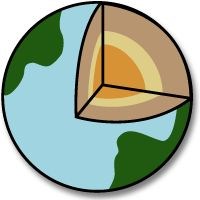
PORTUGUÊS

A IGREJA DE SÃO MIGUEL ARCANJO
A igreja Matriz foi construída em Vila Franca do Campo, até que, em 22 de Outubro de 1522, pelas 2 horas da manha, um terrível cataclismo destruiu quase por completo a primeira capital da ilha. A primeira igreja de São Miguel Arcanjo, foi assim dominada não por a ilha ter sido descoberta no dia 8 de Maio, mas por determinação do Infante D. Pedro, que era muito devoto de São Miguel. Esta foi construída no local onde se situa hoje a praça Bento de Góis. A construção da atual Matriz teve início em 1534, desconhecendo-se a data do termo da sua construção.
Em 1563, o vulcão da Lagoa do Fogo destruiu parcialmente a igreja que foi de novo reconstruída. Mais tarde, em 1630, o vulcão da Lagoa das Furnas danificou grandemente, e, mais uma vez, a mesma igreja, que foi novamente reconstruída.
O bispo da Diocese de Angra, D. Frei Valério do Sacramento determinou, em 1747, que o templo fosse aumentado em altura e que a torre, toda de basalto negro, proveniente das pedreiras da então Vila da Ribeira Grande, igualmente fosse reparada.
Encontramos variedade de estilos, consequências das destruições e reconstruções que sofreu em épocas diferentes. É uma igreja de três naves, com frontispício e torre sineira de basalto. No seu interior encontram-se três naves e a capela-mor, ligada a outras duas laterais. A nave principal está separada das laterais por colunas simples encimadas por arcos ogivais, elenco preponderante no estilo gótico. Cada nave tem no fundo o seu altar, ficando na do centro o principal ou maior, onde se venera e presta o culto ao Glorioso Arcanjo São Miguel, patrono da Vila e padroeiro da Ilha.

XENÓLITOS
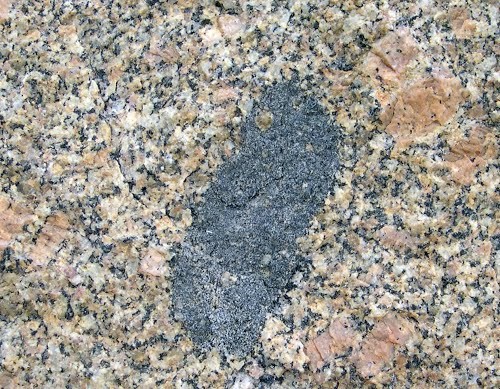
“Um xenólito (do grego para pedra estranha) é um fragmento de rocha que é envolvido por uma rocha maior durante o desenvolvimento e endurecimento desta última. Em geologia este termo é aplicado quase exclusivamente na descrição de inclusões em rochas ígneas durante a colocação e erupção do magma. Os xenólitos podem ser arrastados ao longo da orla de uma câmara magmática, arrancados das paredes de um tubo de lava ou por diatremas explosivos ou arrastados ao longo da base de um fluxo de lava na superfície terrestre. Um xenólito é sempre mais antigo que a sua rocha encaixante.
Um xenocristal é um cristal individual, estranho à rocha encaixante, incluído numa intrusão ígnea. Como exemplos de xenocristais temos os cristais de quartzo em lavas pobres em sílica e os diamantes em diatremas quimberlíticos.
Apesar de ser aplicado sobretudo a rochas ígneas, uma interpretação mais abrangente pode incluir também fragmentos de rocha incluídos em rochas sedimentares. Por vezes são encontrados em meteoritos.
De forma a ser considerado um verdadeiro xenólito, a rocha incluída tem de ser diferente da rocha encaixante; um fragmento incluído de rocha similar à encaixante denomina-se autólito”.
(In wikipédia)

COMPOSIÇÃO E UTILIDADE DOS XENÓLITOS
“Os xenólitos e os xenocristais fornecem informações importantes sobre a composição do manto, doutra forma inacessível. Basaltos, quimberlitos, lamproítos e lamprófiros com origem no manto superior, muitas vezes contêm fragmentos e cristais que se presume fazerem parte da mineralogia do manto de origem.
Xenólitos de dunito, peridotito e espinelo-lherzolitos em fluxos de lava basáltica são um exemplo. Além dos xenocristais de diamante, os quimberlitos contêm fragmentos de lherzolitos de composições variadas. Os minerais contendo alumínio, presentes nestes fragmentos fornecem pistas sobre a profundidade de origem. A plagioclase cálcica é estável à profundidade de 25 km. Entre os 25 e os 60 km, a espinela é a fase estável do alumínio. A profundidade superior a 60 km, a granada densa passa a ser o mineral de alumínio. Alguns quimberlitos contêm xenólitos de eclogito, considerado como produto do metamorfismo de alta pressão sofrido pela crusta oceânica basáltica à medida que esta mergulha no manto em zonas de subducção (Blatt, 1996)”.

BASALTO
O basalto é uma rocha ígnea eruptiva de composição máfica, por isso rica em silicatos de magnésio e ferro e com baixo conteúdo em sílica, que constitui uma das rochas mais abundante na crosta terrestre. É uma rocha de granulação fina, coloração escura, matriz afanítica, frequentemente com textura porfírica, com fenocristais de olivina, augite e plagioclase, e uma matriz cristalina fina. Como minerais acessórios encontram-se, principalmente, óxidos de ferro e titânio.
Ocasionalmente encontram-se basaltos com matriz vítrea, denominados sideromelanos, com raros cristais ou mesmo sem eles. O basalto, pela sua dureza e resistência à meteorização, é muito explorada para a construção civil.
O basalto é similar, em composição e origem, a rochas ígneas máficas como a diabase, o gabro e o andesito. O basalto também ocorre nas superfícies da Lua e de Marte, assim como em alguns meteoritos.

PARA REALIZAR E REGISTAR ESTA EARTHCACHE:
PERGUNTAS:
Para “encontrar/registar” esta cache deverá: provar que esteve no local e responder às seguintes questões, enviando um email/mensagem de Geocaching, com as respostas, em português ou em inglês, para o nosso perfil.
Só depois, de enviar as respostas, e conforme as “guidelines” para as Earthcaches, deverá efetuar o seu registo!
Serão removidos todos os registos que não obedeçam a estes requisitos.
1. Estudando o tema geológico proposto nesta earthcache, responde às seguintes questões:
a) O que são Xenólitos? E Xenocristais?
b) Os Xenólitos são mais antigos ou mais recentes que a rocha-mãe?
2. A partir da tua visita e observações ao GZ desta earthcache, responde às seguintes questões:
a) De que material é construída a frontaria e torre desta Igreja?
b) De onde é proveniente o material utilizado na construção da “fachada” principal desta Igreja?
c) Estima o número de xenólitos presentes na frontaria desta Igreja.
I- Menos de 10; II- Entre 10 e 90; III- Mais de 100;
d) À direita da porta principal (para sul) quais são as cores dos xenólitos presentes?
e) Existem piroclastos entre estes Xenólitos?
f) Existe uma “particularidade” na fachada sul da torre desta Igreja, situada a cerca de 3 metros da esquina da torre e a cerca de 3,5 metros de altura (por cima da data). Descreve-a. Consegues explicar a que se deve?
3. TAREFA OBRIGATÓRIA:Deverá tirar uma foto sua, onde você apareça (ou com um papel/placa onde conste o seu nickname e a data da visita) e que comprove a sua presença no GZ desta EC - NÃO META SPOILERS. Esta foto deverá ser colocada no seu registo ou enviada por email ou sistema de mensagens de Geocaching, para o owner!

Não responderemos ao seu contato, a não ser que haja algum “problema” com as suas respostas ou registo.


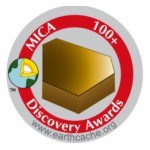
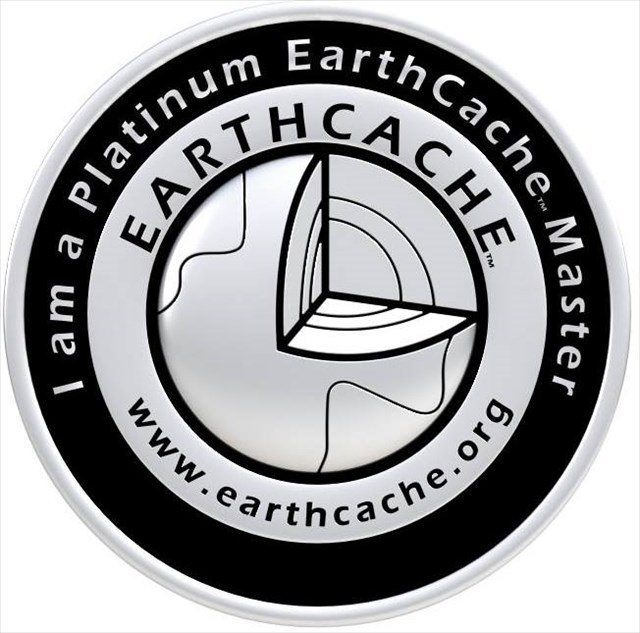

XENOLITHS AT CHURCH
[Vila Franca do Campo – Azores]

ENGLISH

EARTHCACHE

“SÃO MIGUEL ARCANJO” CHURCH
The parish church was built in Vila Franca do Campo, until, on 22 October 1522, at 2 in the morning, a terrible cataclysm destroyed almost completely the first capital of the island. The first church of St. Michael the Archangel, was thus not dominated by the island was discovered on May 8, but by determining the Infante D. Pedro, who was very devoted to St. Michael. This was built on the site where it is located today Benedict square Gois. The construction of the current Matrix began in 1534, not knowing is the expiry date of its construction.
In 1563, the volcano of fire pond partially destroyed the church was again rebuilt. Later, in 1630, the volcano of Lagoa das Furnas damaged greatly, and, again, the same church, which was rebuilt again.
The bishop of the Diocese of Angra, D. Frei Valério Sacramento ruled in 1747 that the temple was increased in height and the tower, all in black basalt from the quarries then the village of Ribeira Grande, was also repaired.
We find variety of styles, consequences of destructions and reconstructions that suffered at different times. It is a church with three naves, with frontispiece and bell tower of basalt. Inside are three naves and the chancel, linked to two other sides. The main nave is separated from the side by simple columns surmounted by pointed arches, leading cast in the Gothic style. Each ship has deep the altar, standing in the main or larger center where venerates and the worshiper to the Glorious Archangel St. Michael, patron of the village and patron of the island.

XENOLITHS

"A xenolith (Greek for odd stone) is a fragment of rock that is surrounded by a larger rock during development and curing thereof. In geology this term is used almost exclusively to describe inclusions in igneous rock during placement and eruption of magma. The xenoliths can be dragged along the edge of a magma chamber, torn from the walls of a lava tube or explosive diatremes or dragged along the base of a lava flow on Earth's surface. A xenolith is always older than its host rock.
A xenocristal is a single crystal, foreign to the host rock, including an igneous intrusion. Examples of xenocrysts have quartz crystals in poor lavas silica and diamonds in diatremes quimberlíticos.
Despite being applied above the igneous rocks, a broader interpretation may also include rock fragments included in sedimentary rocks. They are sometimes found in meteorites.
In order to be considered a true xenolith, the included rock must be different from the host rock; included a fragment of rock similar to the wall rock is called autólito”.
(In wikipédia)

COMPOSITION AND UTILITY OF XENOLITHS
"The xenoliths and single crystals provide important information about the composition of the mantle of another inaccessible form. Basalts, kimberlites, and lamproites lamprophyres originating from the upper mantle, often contain fragments and crystals that are assumed are part of the mineralogy of the mantle source.
Xenoliths of dunite, peridotite and espinelo-lherzolites in basaltic lava flows are one example. Besides diamond xenocrysts Kimberlite lherzolites contain fragments of varying compositions. Minerals containing aluminum, present in these fragments provide clues about the depth of origin. The calcic plagioclase is stable at a depth of 25 km. Between 25 and 60 km, the spinel is the stable phase of aluminum. The depth of more than 60 km, dense garnet becomes the aluminum mineral. Some kimberlites contain xenoliths of eclogite, considered as high-pressure metamorphism of the product suffered by the basaltic oceanic crust as this plunges into the mantle in subduction zones (Blatt, 1996). "
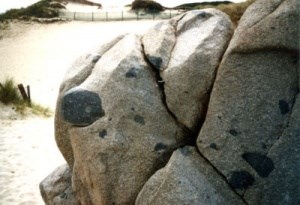
BASALT
Basalt is an eruptive igneous rock mafic composition, so rich in magnesium and iron silicates with low silica content, which is one of the most abundant in crustal rocks. It is a rock of fine-grained, dark colored, aphanitic matrix, often with porphyritic texture, with phenocrysts of olivine, augite and plagioclase, and a fine crystalline matrix. As accessory minerals are mainly iron oxides and titanium.
Occasionally are basalts glass matrix, called sideromelanos with rare crystals or even without them. Basalt, for its hardness and resistance to weathering, it is exploited for construction.
Basalt is similar in composition and origin, mafic igneous rocks such as diabase, gabbro and andesite. Basalt also occurs on the surfaces of the Moon and Mars, as well as in some meteorites.

TO PERFORM AND LOG THIS EarthCache:
QUESTIONS:
To "find / register" this cache must: prove that visited the site and answer the following questions by sending an email / message Geocaching, with answers (in Portuguese or in English, only) to our profile.
Only later, sending the answers, and as the "guidelines" for EarthCaches should make your registration! They will be removed from all records that do not meet these requirements.
1. Studying the geological theme proposed this EarthCache, answer the following questions:
a) What are Xenoliths? And Xenocrysts?
b) Xenoliths are older or newer than the bedrock?
2. From your visit and comments to GZ EarthCache this, answer the following questions:
a) What material is constructed facade and tower of this church?
b) Where it is from the material used in the construction of "facade" principal of this Church?
c) Estimated the number of xenoliths present in front of this church.
I- less than 10; II- Between 10 and 90; More III- 100;
d) The right of the main entrance (south) which are the colors of xenoliths present?
e) There are tephra between these Xenoliths?
f) There is a "feature" in the south facade of the tower of this church, situated about 3 meters from the corner of the tower and about 3.5 meters high (above the date). Disclosed a. Can you explain that to?
TASK (not optional): You must take a picture of yourself, where do you show up, (or with a paper / plaque with your geocaching nickname and the date of the visit) and that proves your presence in the GZ of this EC - no spoilers please. This photo must be placed in your log or sent by email or Geocaching messaging system, to the owner!
We do not respond to your touch, unless there is a "problem" with their answers or register.